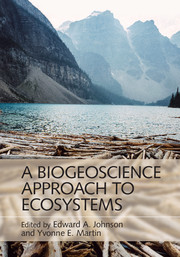Book contents
- Frontmatter
- Contents
- List of contributors
- Preface
- Miscellaneous Frontmatter
- 1 Introduction
- Part I Connecting Ecosystem and Geoscience Processes
- Part II Transport Processes and Conservation Budgets in Biogeoscience
- Part III Coupling Hillslope Geomorphology, Soils, Hydrology, and Ecosystems
- 5 Landscape Evolution Models and Ecohydrologic Processes
- 6 Soil Mantled Hillslopes: Intersections of Geomorphology, Soil Science, and Ecology
- 7 Interactions between Precipitation and Vegetation Canopies
- 8 Constraints on Nutrient Dynamics in Terrestrial Vegetation
- 9 Evapotranspiration
- Part IV Coupling Fluvial and Aeolian Geomorphology, Hydrology/Hydraulics, and Ecosystems
- Index
- References
9 - Evapotranspiration
from Part III - Coupling Hillslope Geomorphology, Soils, Hydrology, and Ecosystems
Published online by Cambridge University Press: 27 October 2016
- Frontmatter
- Contents
- List of contributors
- Preface
- Miscellaneous Frontmatter
- 1 Introduction
- Part I Connecting Ecosystem and Geoscience Processes
- Part II Transport Processes and Conservation Budgets in Biogeoscience
- Part III Coupling Hillslope Geomorphology, Soils, Hydrology, and Ecosystems
- 5 Landscape Evolution Models and Ecohydrologic Processes
- 6 Soil Mantled Hillslopes: Intersections of Geomorphology, Soil Science, and Ecology
- 7 Interactions between Precipitation and Vegetation Canopies
- 8 Constraints on Nutrient Dynamics in Terrestrial Vegetation
- 9 Evapotranspiration
- Part IV Coupling Fluvial and Aeolian Geomorphology, Hydrology/Hydraulics, and Ecosystems
- Index
- References
Summary
Introduction
The Process of Evapotranspiration
Evapotranspiration (E) is the combined processes of physical evaporation and biological transpiration, by which liquid water from open water, soil, and vegetation surfaces is transformed into vapor and transported into the atmosphere. For terrestrial ecosystems, these three components are referred to as evaporation from bare soil (E s ), transpiration or water use by growing vegetation (E t), and evaporation from wet foliage of intercepted water (E i ). Sublimation, the transformation of solid water (i.e., ice or snow) to water vapor, though generally considered separate from evapotranspiration, is considered here as part of E s or E i as the case may be.
Energy is required to change the state of the molecules of water from liquid to vapor. This energy is known as the latent heat of vaporization of water (λ), and is provided by solar irradiance (R s ) and, to a lesser extent, the ambient temperature of the air (T a ). Also, as the liquid water intermolecular attractions decrease with the increase in temperature, λ decreases slightly with increasing temperature. The driving force to remove water vapor from the evaporating surface is the difference between the water vapor pressure at the evaporating surface and that of the surrounding atmosphere. As evaporation proceeds, the surrounding air becomes gradually saturated and the process will slow down and might stop if the wet air is not transferred to the atmosphere. As the replacement of the saturated air with drier air depends greatly on wind speed, air humidity and wind speed are also important controls of E. In the case of transpiration, liquid water, together with some nutrients, is taken up by the roots and transported through the plant to the leaves. While conversion of liquid water contained in plant tissues to water vapor occurs in the stomatal cavities of the leaf, vapor exchange with the atmosphere occurs through stomata. Thus, energy is required for evapotranspiration (evaporation from wet leaves and transpiration) to proceed from vegetation. In fact, the concept of evapotranspiration can be simplified as “water + energy = evapotranspiration.”
- Type
- Chapter
- Information
- A Biogeoscience Approach to Ecosystems , pp. 292 - 344Publisher: Cambridge University PressPrint publication year: 2016
References
- 1
- Cited by



